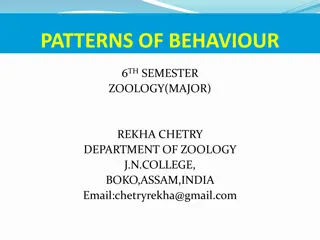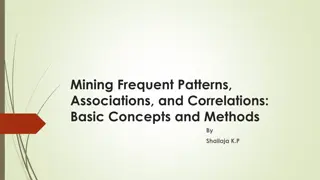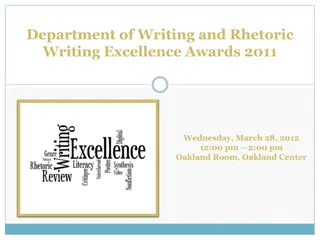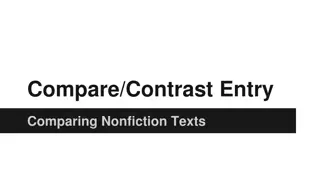Understanding Organizational Patterns in Nonfiction Writing
Explore the key organizational patterns in nonfiction writing through the lenses of cause & effect and compare & contrast. Learn how each pattern helps present information logically and clearly, with examples and interactive activities to enhance understanding.
Download Presentation

Please find below an Image/Link to download the presentation.
The content on the website is provided AS IS for your information and personal use only. It may not be sold, licensed, or shared on other websites without obtaining consent from the author. Download presentation by click this link. If you encounter any issues during the download, it is possible that the publisher has removed the file from their server.
E N D
Presentation Transcript
EXPOSITORY TEXT ORGANIZATIONAL PATTERNS NONFICTION WRITING
Organizational Patterns Used to present information in a clear and logical way Develops the main idea We will learn about the 5 most common Organizational Patterns
CAUSE & EFFECT Explain reasons why something happened and the effects of something. THE CAUSES MAKE THE EFFECTS HAPPEN. USE A MULTI-FLOW MAP. CAN START WITH EITHER THE CAUSES OR EFFECTS-DOESN T MATTER. Transitional Words= because, as a result, resulted, caused, affected, since, due to, effect.
Example: Students are not allowed to chew gum in my class. There are many good reasons for this rule. First, some irresponsible students make messes with their gum. They leave it underneath desks, drop it on the floor, or put it on other people s property. Another reason why I don t allow students to chew gum is because it is a distraction. When they are allowed to chew gum, students are more worried about having it, popping it, chewing it, and snapping it then they are in listening, writing, reading, and learning.
Turn & Talk Partner 1: What is the most important thing to remember about the Cause & Effect organizational pattern? Partner 2: Give a cause & effect example. (Effect=I got sick Cause=I didn t wash my hands.)
COMPARE & CONTRAST Used to find BOTH the similarities & differences Use a double bubble map. signal words : like, unlike, both, neither, similar, and different.
Example: Apples and oranges are both fruits, which means that they have seeds inside of them. Each has a skin, but orange skins are thick and easy to peel. Apple skins are thinner and do not peel easily. Oranges also contain more acid than apples, but both fruits are delicious.
Turn & Talk Partner 2: Summarize what you learned about the compare & contrast organizational pattern. Partner 1: Add something that your partner forgot.
PROBLEM & SOLUTION A concerning issue is presented & discussion on what could/should be done to fix it. Is frequently confused with cause and effect, but look specifically for both a problem and a solution to the problem. Often Answers the question, Why . Transitional/Signal Words : propose, solution, answer, issue, problem, problematic, remedy, prevention, and fix.
Example: Why the lawn mower was invented. The Problem: Grass was growing too high and was hard to get rid of. The Solution: The lawn mower was invented to easily allow people to shorten grass levels. Problem Solution
Turn & Talk Partner 1: What types of problems might be presented in news articles? Partner 2: What solutions might be suggested to some of the problems your partner mentioned?
Process/Sequential/Chronological Organized in the order that it happens. Instructions, Directions, to Explain a Process, or recounted events (process of electing a president) Chronological order has a TIME component. (date, years, 5pm) Process/Sequence concerned with order only. (Can complete the steps any time, but must be in a certain sequence) Use the Flow Map to show the steps in order. Transitional Words: First, next, before, lastly, then
Example: How to Make Cookies. First, get your materials. Then, make your dough. Lastly, cook your dough at 400 degrees for 10 minutes.
Example: This morning was crazy. My alarm clock was set for PM instead of AM, so I woke up really late. I just threw on some clothes and ran out the door. I rode my bike as fast as I could and thought that I was going to be late for sure, but when I got there everyone was outside and there were fire trucks all lined up in front of school. I guess somebody pulled the fire alarm before class started. It worked out though, because nobody really noticed or minded that I was tardy.
Turn & Talk Partner 2: What is the difference between Sequential & Chronological Order? Partner 1: Give an example of something that has to be completed in a certain order.
DESCRIPTION Presents a topic and provides details about it. Use either a bubble map or circle map (Or Both) Examples: Books about Bats, Planets, Global Warming, Bullying, Magic Johnson, etc.
Turn & Talk Partner 2: Which thinking map would you prefer to use if you were taking notes over a descriptive text? Why? Partner 1: Discuss some topics that you might find in a descriptive text.
Check your notes while watching to see if you missed any important details. https://www.youtube.com/watch?v=50GwjM XhSjU























